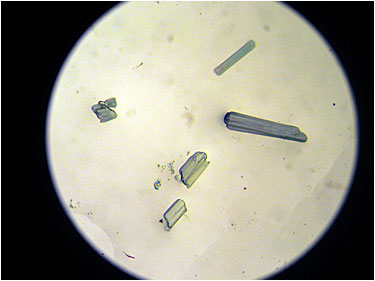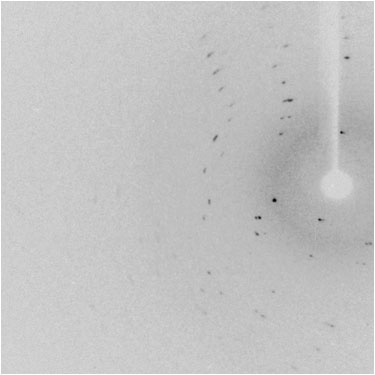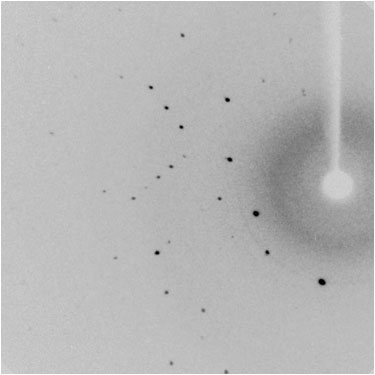"All we have discovered is that it starts with a single individual - always a child - and then spreads explosively, like the formation of crystals round the first nucleus in a saturated solution." Arthur C. Clarke (Childhood's End, 1953)
Submission
In order to process your request, an application form must be submitted for each individual sample. Our X-ray facility operates on the basis of first-come first-served policy (exceptions can be made for special cases). When you submit your sample(s), please remember it is always best to keep your crystals within the mother liquor/solvent. Doing so might prevent crystal decomposition (especially if the crystal lattice contains some solvent), and allows to pick crystals more readily from the batch (and therefore prevents crystal damage). Herein is the procedure to follow:
- Download the submission form (a fillable doc or pdf file) - doc | pdf.
- Fill out the form by providing all necessary information regarding your sample (this is important!).
- Print, fax (410 516 7044) or email (xray@jhu.edu) the form.
Each sample will be then carefully examined under a stereomicroscope
for a preliminary checking. If the sample contains crystals, then a
small amount of crystals will be placed on a microscope slide (with
some paratone oil) and will be further inspected under cross-polarized
light. Most often crystals are found to be single but sometime are found
to be twinned. When twin domains are clearly distinguishable (which
is often the case), it generally takes little effort to perform microsurgeries
on twinned crystals, for which individual domains can be separated (please
note this practice might be more difficult with plate-like crystals).
Although crystals may appear of good quality (e.g., large crystals,
well-defined crystal faces, sharp edges, smooth crystal faces), the
last stage of the preliminary examination is to collect a few frames
in order to evaluate the diffraction quality. Diffraction patterns of
good quality will feature sharp and unsplit reflections at low and high
resolution.
 Crystals of poor quality |
 Crystals of good quality |
 Diffraction pattern of poor quality |
 Diffraction pattern of good quality |
Zip
When X-ray structure determination has been completed, a zip archive file is sent to you via email within 1-2 business days for straightforwad structures or within several days/weeks for difficult structures. A preliminary plot showing the chemical connectivity may be sent to you within the first day of data collection.
An unique reference code is given for each individual structure. The code is referenced as x####n for academic users and as cx####n for non-academic users [x stands for X-ray and cx stand for commercial X-ray; #### is the numbering scheme; n corresponds to the number of attempts done for the same structure and takes the values a (first attempt), b (second attempt), etc.]. Subsequently, the zip file is named either x####n.zip or cx####n.zip.
When the zip file is uncompressed, the structure directory x####n or cx####n is created, and includes 7 subdirectories:
- (c)x####n/bill: this subdirectory contains the issue receipt (pdf
file).
- (c)x####n/cif_final: this subdirectory contains the (c)x####n_final.cif
file. This cif file (CIF = Crystallography Information File) includes
all necessary information related to the crystal structure and experimental
data. This file MUST BE submitted along with your
manuscript to the journal of interest. Some journals require to deposit
your cif file(s) with the CCDC prior to your manuscript submission.
If so, please follow this link
for further instructions.
- (c)x####n/crystal_morphology: this subdirectory contains two digitalized
photographs of the crystal that was used for data collection.
- (c)x####n/experimental_report: this subdirectory contains the experimental.cif
and (c)x####n_report.doc files. The experimental.cif file only includes
general information about data collection and MUST NOT BE
supplied through the process of submitting your manuscript. The .doc
file includes the experimental section about X-ray crystallography
and the text should be appended either in the manuscript or in the
supporting information.
- (c)x####n/ortep: this subdirectory includes one or several displacement
ellipsoid plots (generally drawn at 50% probability level) of the
compound of interest. Such plots are typically generated from XP (Shelxtl
program), but can also be generated from PLATON
or Mercury
as well.
- (c)x####n/platon_report: the subdirectory includes the (c)x####n.chk
(cif-file validation) and (c)x####n.ckf (fcf-file validation) files,
which are both generated from PLATON. These files are valuable for
the crystallographers, but probably not so relevant for the chemists.
- (c)x####n/refin: the subdirectory includes all necessary files (.res and .hkl) used for the structure refinement.
Copyright © 2009-2014 - JHU X-ray Crystallography Facility v2.0 - Maxime Siegler